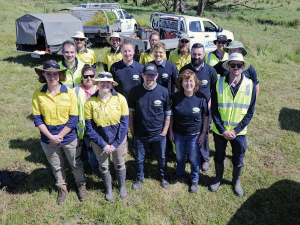Fonterra slashes forecast milk price, again
Fonterra has slashed another 50c off its milk price forecast as global milk flows shows no sign of easing.
 Fonterra has kicked off its spring vegetation project, planting 20,000 native plants and trees across four hectares to form a riparian zone around its Darnum plant in Victoria.
Fonterra has kicked off its spring vegetation project, planting 20,000 native plants and trees across four hectares to form a riparian zone around its Darnum plant in Victoria.
Leading in sustainability is central to Fonterra’s strategy, both here and overseas, the co-operative claims.
The co-operative says that’s how it creates long-term value for the business and generations to come.
“We’re making sustainable improvements right across our business, including how we care for the ecosystems surrounding our manufacturing sites,” it says.
These improvements are not limited to New Zealand. In Gippsland, Victoria, Fonterra’s Darnum site is located on a 280-hectare property, of which only around 6% is used for manufacturing.
It’s here that the co-op kicked off its spring vegetation project, planting 20,000 native plants and trees across four hectares to form a riparian zone.
Paul Winfield, Fonterra’s environmental manager at Darnum, says that re-vegetation projects like these play an important part in protecting and nurturing the ecosystems surrounding its site.
“We want to ensure that we’re producing dairy nutrition in a way that cares for the environment, and part of this is caring for the land around us.
“To make this happen, we’ve partnered with Habitat Creations, a local family-owned company that specialises in conservation, land management and native plant supply via its Wholesale Nursery.
“While the high volume of rainfall we’ve had over the past couple of months delayed the start, it’s great to finally break ground and get the project underway,” says Winfield.
Using plants grown from local provenance seeds, Habitat Creations – along with some people from our site – took on the task to plant out the riparian area.
Michael Shore, general manager at Habitat Creations, says that planting a diverse mix of tall canopy trees and understory species complements the existing native plants already on site.
“These plants and trees will help absorb nutrient run-off and prevent it from getting into the waterway, and will also have significant advantages for local biodiversity – creating a habitat, refuge, and a corridor for wildlife movement to the neighbouring wetlands.
“When fully planted, this area will also have the potential to sequester significant amounts of carbon which will help reduce levels of CO2 – we estimate up to forty tonnes every year over a 25-year period,” says Shore.
This spring vegetation project is just one of many environmental initiatives taking place at Fonterra’s Darnum site.
The co-op has just started introducing solar energy to sites by commissioning a 66kw solar system on the administration building.
Dairy prices have jumped in the overnight Global Dairy Trade (GDT) auction, breaking a five-month negative streak.
Alliance Group chief executive Willie Wiese is leaving the company after three years in the role.
A booklet produced in 2025 by the Rotoiti 15 trust, Department of Conservation and Scion – now part of the Bioeconomy Science Institute – aims to help people identify insect pests and diseases.
A Taranaki farmer and livestock agent who illegally swapped NAIT tags from cows infected with a bovine disease in an attempt to sell the cows has been fined $15,000.
Bill and Michelle Burgess had an eye-opening realisation when they produced the same with fewer cows.
It was love that first led Leah Prankerd to dairying. Decades later, it's her passion for the industry keeping her there, supporting, and inspiring farmers across the region.
President Donald Trump’s decision to impose tariffs on imports into the US is doing good things for global trade, according…
Seen a giant cheese roll rolling along Southland’s roads?